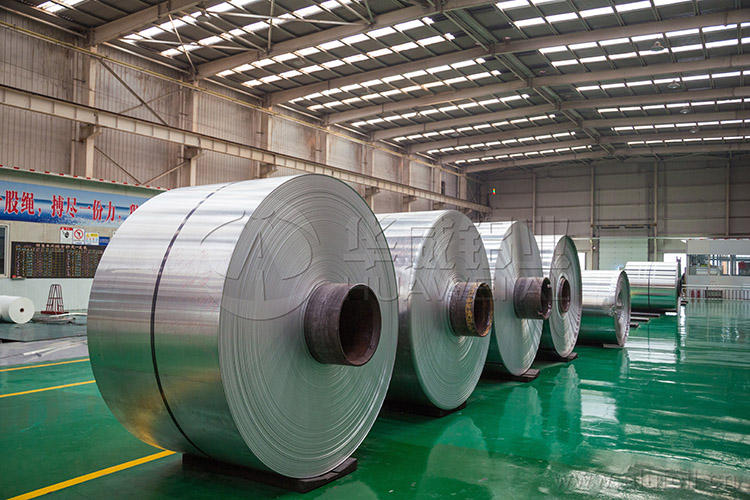The main component of the 5aluminiu seria xxx este magneziu, și o cantitate mică de mangan, crom, se adaugă titan și alte elemente, iar elementele de impuritate sunt în principal fier, siliciu, cupru, zinc și așa mai departe. Rolul specific este introdus după cum urmează:
(1) Magneziu: Magneziul există în principal în stare de soluție solidă și β (Mg 2 Al 3 sau Mg 5 Al 8) fază. Although the solubility of magnesium in the alloy decreases rapidly with the decrease of temperature, it is difficult to precipitate and nucleate. Less, the precipitated phase is coarse, so the aging strengthening effect of the alloy is low, and it is generally used in the annealing or cold working state. Prin urmare, this series of alloys are also called non-strengthable aluminum alloys. The strength of this series of alloys increases with the increase of magnesium content, while the plasticity decreases accordingly, and its processing performance also deteriorates. Magnesium content has a great influence on the recrystallization temperature of the alloy. Când ω(Mg)<5%, the recrystallization temperature decreases with the increase of magnesium content; când ω(Mg)>5%, the recrystallization temperature changes with the magnesium content. Increase and increase. The magnesium content also has a significant effect on the welding performance of the alloy. Când ω(Mg)<6%, the welding crack tendency of the alloy decreases with the increase of the magnesium content. Când ω(Mg)>6%, the opposite is true; când ω( When Mg)<9%, the strength of the weld increases significantly with the increase of magnesium content. Momentan, although the plasticity and welding coefficient gradually decrease slightly, the change is not significant. When the magnesium content is greater than 9%, its strength, plasticity and The welding coefficients are significantly reduced.

(2) Mangan: În 5 aliaj de aluminiu de serie, Oh(Mn)<1.0% is usually. Part of the manganese in the alloy is dissolved in the matrix, and the rest exists in the structure in the form of MnAl 6 fază. Manganese can increase the recrystallization temperature of the alloy, prevent the coarsening of crystal grains, and slightly increase the strength of the alloy, especially the yield strength. In high-magnesium alloys, the addition of manganese can reduce the solubility of magnesium in the matrix, reduce the tendency of weld cracks, and increase the strength of the weld and the base metal.
(3) Crom: Cromul și manganul au efecte similare, which can increase the strength of the base metal and the weld, reduce the tendency of welding hot cracking, and improve the stress corrosion resistance, but the plasticity is slightly reduced. Chromium can be used instead of manganese in some alloys. In terms of strengthening effect, chromium is not as good as manganese. If the two elements are added at the same time, the effect is greater than the single addition.
(4) Beryllium: adding a small amount of be (Oh(Be)=0.0001%~0.005%) to the high-magnesium alloy can reduce the cracking tendency of the ingot and improve the surface quality of the rolled plate, and at the same time reduce the burning of magnesium during smelting It can also reduce the oxides formed on the surface of the material during the heating process.
(5) Titan: A small amount of titanium is added to the high-magnesium alloy, mainly for grain refinement.
(6) Fier: Iron can form insoluble compounds with manganese and chromium, thereby reducing the role of manganese and chromium in the alloy. When more hard and brittle compounds are formed in the ingot structure, processing cracks are likely to occur. în plus, iron will also reduce the corrosion resistance of this series of alloys, so in general, Oh(Fe)<0.4% should be controlled, and ω(Fe)<0.2% for welding wire materials.
(7) Siliciu: Silicon is a harmful impurity (except 5A03 alloy). Silicon and magnesium form a Mg 2 faza Si. The excessive magnesium content reduces the solubility of the Mg 2 Si phase in the matrix, so not only does it have little strengthening, but also reduces The plasticity of the alloy. When rolling, silicon has a greater negative effect than iron, so generally should limit ω (Si) <0.5%. In 5A03 alloy, Oh(Si)=0.5%~0.8%, which can reduce the tendency of welding cracks and improve the welding performance of the alloy.
(8) Cupru: A small amount of copper can make the corrosion resistance of the alloy worse, so ω(Cu) should be restricted to <0.2%, and some alloys are restricted more strictly.
(9) Zinc: Când ω(Zn)<0.2%, it has no obvious influence on the mechanical properties and corrosion resistance of the alloy. Adding a small amount of zinc to the high-magnesium alloy can increase the tensile strength by 10-20MPa. The impurity ω(Zn) in the alloy should be limited to <0.2%.
(10) Sodium: Trace impurity sodium can strongly damage the thermal deformation properties of the alloy, și "sodium brittleness" appears, which is more prominent in high-magnesium alloys. The method to eliminate sodium brittleness is to make the free sodium enriched in the grain boundary into a compound. The chlorination method can be used to produce NaCl and be discharged with the slag, or the method of adding a small amount of antimony can be used.
